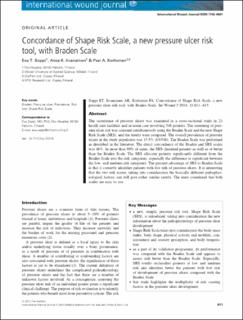| dc.contributor.author | Soppi, E. T. | |
| dc.contributor.author | Iivanainen, A. K. | |
| dc.contributor.author | Korhonen, P. A. | |
| dc.date.accessioned | 2021-07-09T11:23:36Z | |
| dc.date.available | 2021-07-09T11:23:36Z | |
| dc.date.issued | 2012 | |
| dc.identifier.citation | Soppi, E. T., Iivanainen, A. K. & Korhonen, P., A. (2012). Concordance of Shape Risk Scale, a new pressure ulcer risk tool, with Braden Scale. International Wound Journal, 11(6), 611–5. | en_US |
| dc.identifier.uri | https://hdl.handle.net/11250/2764046 | |
| dc.description.abstract | The occurrence of pressure ulcers was examined in a cross-sectional study in 23 health care facilities and in home care involving 548 patients. The screening of pressure ulcer risk was assessed simultaneously using the Braden Scale and the new Shape Risk Scale (SRS), and the results were compared. The overall prevalence of pressure ulcers in the study population was 15·5% (85/548). The Braden Scale was performed as described in the literature. The direct concordance of the Braden and SRS scales was 46%. In more than 90% of cases, the SRS classified patients as well as or better than the Braden Scale. The SRS allocates patients significantly different from the Braden Scale into the risk categories, especially the difference is significant between the low and medium-risk categories. The greatest advantage of SRS to Braden Scale is that it correctly identifies patients with low risk of pressure ulcers. It is interesting that the two risk scores, taking into consideration the basically different pathophysiological factors, can still give rather similar results. The users considered that both scales are easy to use. | en_US |
| dc.publisher | International Wound Journal | en_US |
| dc.rights | Navngivelse 4.0 Internasjonal | |
| dc.rights.uri | http://creativecommons.org/licenses/by/4.0/deed.no | |
| dc.subject | Braden | en_US |
| dc.subject | pressure ulcer | en_US |
| dc.subject | prevalence | en_US |
| dc.subject | risk tool | en_US |
| dc.subject | Shape Risk Scale | en_US |
| dc.title | Concordance of Shape Risk Scale, a new pressure ulcer risk tool, with Braden Scale | en_US |
| dc.type | Journal article | en_US |
| dc.source.pagenumber | 611-615 | en_US |
| dc.source.volume | 11 | en_US |
| dc.source.journal | International Wound Journal | en_US |
| dc.source.issue | 6 | en_US |
| dc.identifier.doi | https://doi.org/10.1111/iwj.12015 | |

